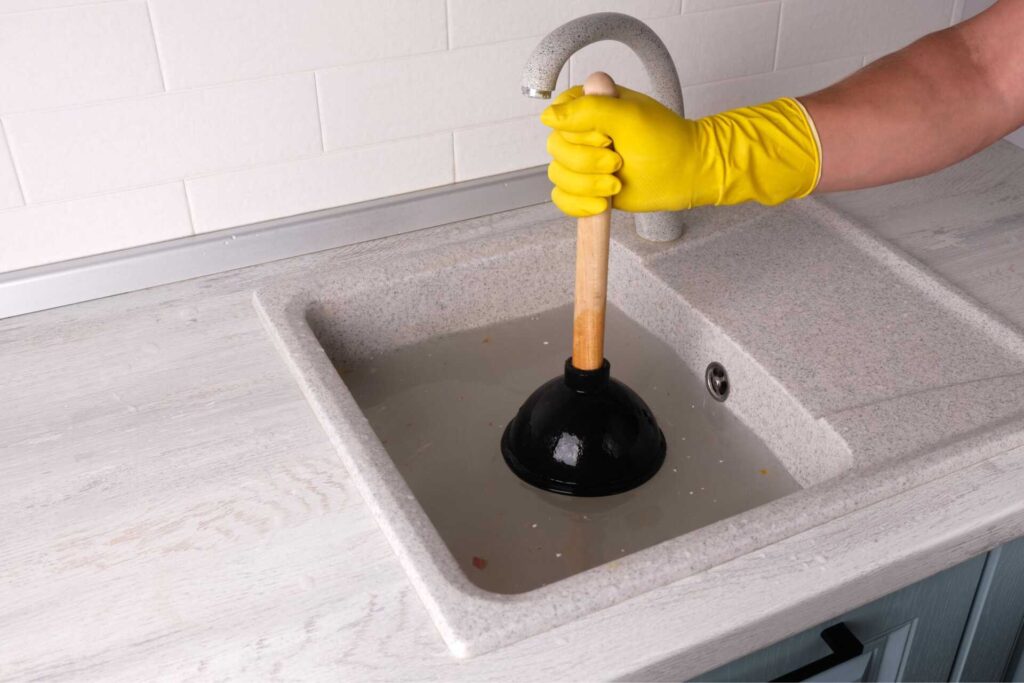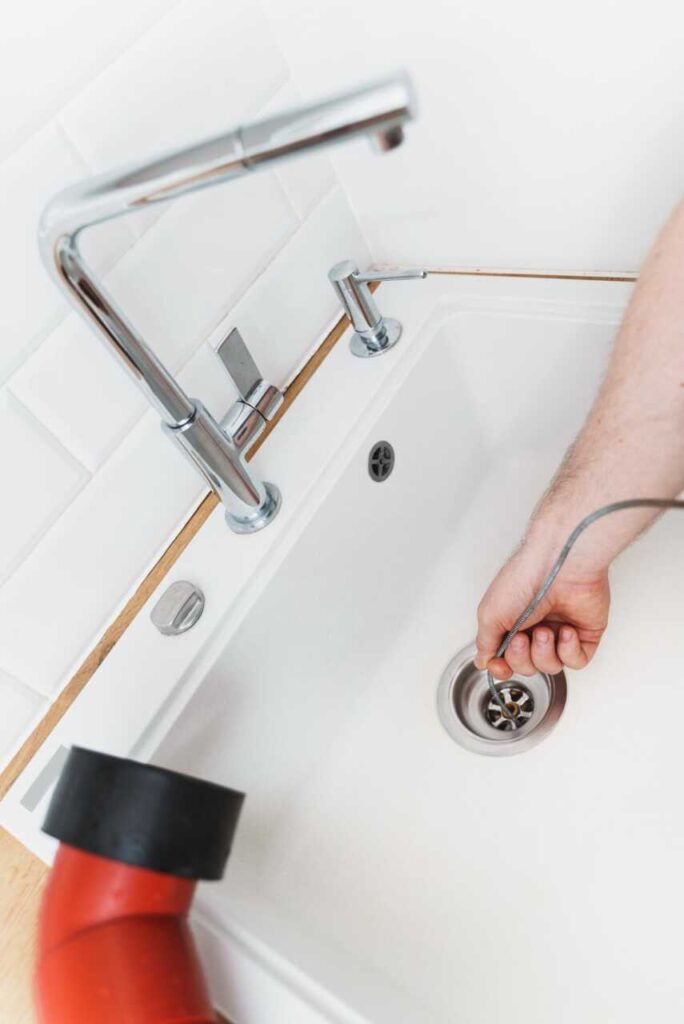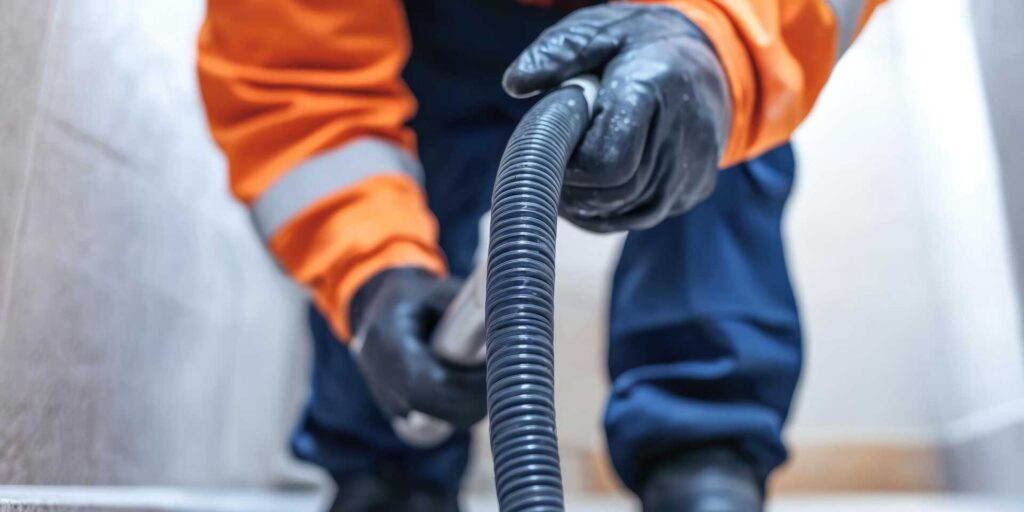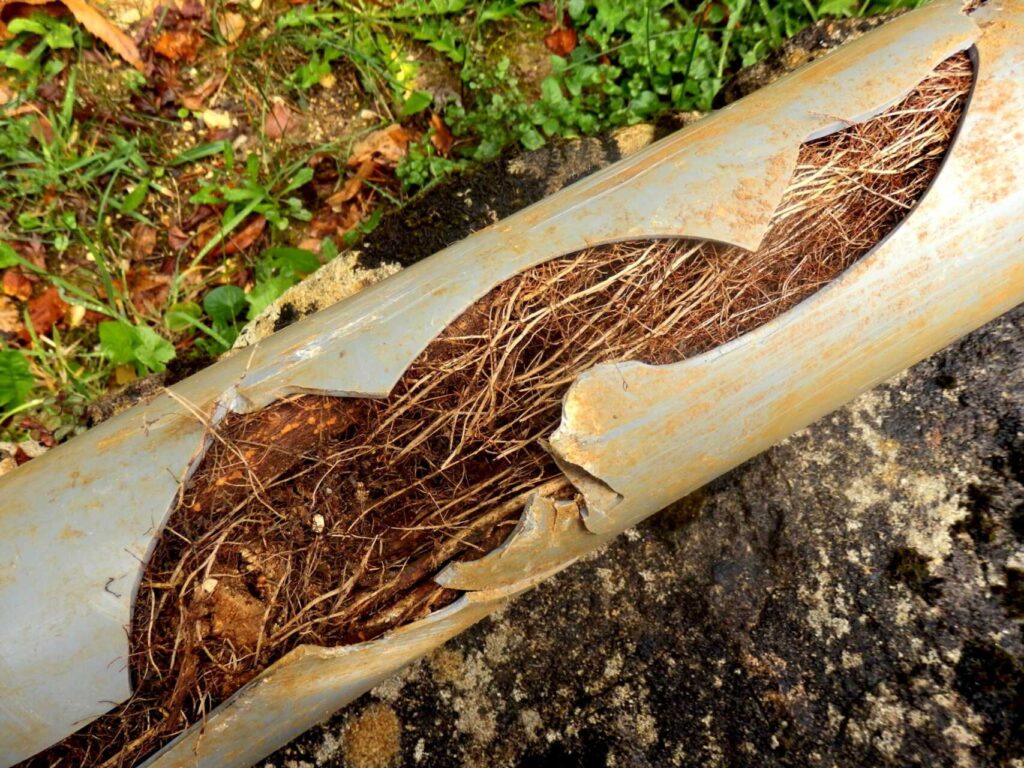
Contents
Unclogging Drains doesn’t have to be a hassle. When you’re faced with a clogged drain, it’s tempting to reach for chemical solutions that promise quick fixes, but those can often do more harm than good. Instead, you should consider safer techniques that protect both your plumbing and your health. Starting with simple tools like a plunger or drain snake can often resolve minor issues effectively. But if those don’t work, you might be surprised by the power of everyday household items like baking soda and vinegar. Let’s explore these methods further to guarantee you tackle drain clogs safely and efficiently.
Key Takeaways
- Use a plunger as the first line of defense to dislodge minor clogs safely and effectively.
- Pour boiling water in stages to dissolve grease and soap buildup without damaging pipes.
- Combine baking soda and vinegar for an eco-friendly method that creates a fizzing reaction to clear clogs.
- Employ a drain snake to reach deep clogs; ensure to rotate it to break apart the blockage.
- Regularly remove hair and debris from drains and use drain covers to prevent future clogs.
Understanding Drain Clogs
When you notice water pooling in your sink or tub, it’s likely a sign of a drain clog. Understanding drain anatomy is essential in addressing this issue effectively. Drains consist of various components, including the sink or tub, trap, and drainpipes. Each part plays a role in ensuring smooth water flow. When debris accumulates, it can obstruct this flow, leading to frustrating backups.
To prevent clogs from forming, you should adopt proactive clog-prevention methods. Start by using drain covers to catch hair and larger particles before they enter the drain. Regularly cleaning these covers can stop buildups from occurring. You might also consider flushing your drains with hot water periodically. This simple action can help dissolve any grease or soap residue that may accumulate over time.
Another effective strategy is using a mixture of baking soda and vinegar. Pouring this combination down the drain can break down minor clogs and maintain clear pipes. Additionally, it’s wise to avoid pouring oils or fats down the drain, as they can solidify and cause significant blockages.
Common Causes of Blockages
You might be surprised by how easily drains can become blocked. Common culprits include food waste accumulation and hair combined with soap residue, which can create stubborn clogs. Understanding these causes helps you take proactive measures to prevent blockages in the future.
Food Waste Accumulation
Although food waste is a common byproduct of daily cooking and dining, improper disposal can lead to significant drain blockages. You may unknowingly contribute to these issues if you dispose of certain items down the drain. Here are some common culprits to watch out for:
- Grease and Oils: These can solidify in your pipes, creating stubborn clogs.
- Coffee Grounds: They can accumulate and form a thick sludge that obstructs flow.
- Starchy Foods: Items like pasta and rice expand when wet, leading to blockages.
- Fruit and Vegetable Peels: These can create a tangled mess in your plumbing.
To mitigate these issues, consider proper food disposal techniques. Instead of pouring grease down the sink, let it cool and dispose of it in the trash. You might also explore composting methods for organic waste, turning scraps into nutrient-rich soil instead of clogging your drains. By adopting these practices, not only will you maintain clear plumbing, but you’ll also contribute positively to the environment. Remember, a little awareness goes a long way in keeping your drains functional.
Hair and Soap Residue
While showering or washing your hands, hair and soap residue often combine to create a significant risk for drain blockages. This mixture can lead to substantial soap buildup, which clings to pipe walls and traps hair, exacerbating the problem over time. Understanding this process is essential for maintaining a clear drainage system in your home.
To combat hair and soap residue, you should prioritize regular hair removal from your drains. Use a drain cover to catch hair before it enters the plumbing, and make it a habit to clean it out frequently. Additionally, consider using a mixture of baking soda and vinegar periodically. This natural solution can help break down soap buildup and prevent blockages.
When washing, opt for biodegradable soaps that dissolve more easily, reducing the chance of soap residue accumulating. If you notice slow drainage, take immediate action before the problem escalates. By being proactive about hair removal and monitoring soap buildup, you can safeguard your plumbing and avoid costly repairs. Remember, maintaining a clean drain is a shared responsibility that protects your home and the community’s plumbing systems.
Tools for Safe Drain Cleaning
To effectively unclog drains, you’ll need the right tools at your disposal. Essential drain cleaning tools, along with proper safety gear, guarantee you can tackle blockages efficiently and safely. Understanding these tools and their applications will help you maintain a clear and functional drainage system.
Essential Drain Cleaning Tools
When tackling a clogged drain, having the right tools at your disposal is essential for effective and safe cleaning. Utilizing the proper equipment not only aids in resolving the issue but also promotes ongoing drain maintenance. Here are four vital tools you’ll want to keep handy:
- Plunger: This is your first line of defense. Mastering effective plunging techniques can often clear minor clogs without further intervention.
- Drain Snake: A flexible drain snake can reach deep clogs that a plunger can’t handle. It’s great for stubborn blockages caused by hair or debris.
- Bucket: When you’re working on a clogged sink, a bucket catches excess water and prevents messy spills. It’s a simple yet important tool for any drain cleaning process.
- Rubber Gloves: Protect your hands while you work. Gloves provide a barrier against bacteria and grime, ensuring a safer cleaning experience.
Safety Gear Importance
Ensuring your safety during drain cleaning is essential, as working with clogged drains can expose you to harmful bacteria and hazardous materials. To protect yourself, always prioritize safety precautions and invest in the right protective equipment.
Start with gloves made of rubber or nitrile, which will safeguard your hands from sharp objects and potential contaminants. A good pair of safety goggles is vital, too; they’ll shield your eyes from splashes and debris that can arise when you’re working on stubborn clogs. If you’re using chemical drain cleaners, consider wearing a mask to prevent inhaling toxic fumes.
Additionally, sturdy footwear, such as rubber boots, provides added protection against spills and slippery surfaces. If the job requires it, a waterproof apron can keep your clothing dry while you work.
Boiling Water Method
One effective method for unclogging drains involves using boiling water, a technique that can clear minor blockages caused by grease, soap scum, or food particles. This method is straightforward and a valuable part of your drain maintenance routine. Here’s how to do it safely and effectively:
- Boil Water: Start by bringing a pot of water to a rolling boil. Confirm you have enough water to pour into the affected drain.
- Prepare the Area: Clear the area around the sink or tub to prevent accidents. It’s also wise to remove any visible debris from the drain.
- Pour Slowly: Once the water reaches boiling, carefully pour it into the drain in two to three stages. Allow the hot water to work for a minute or two between pours. This helps to break down the clog gradually.
- Repeat if Necessary: If the drain isn’t fully cleared after the first attempt, repeat the process. You may need to boil more water if the blockage is stubborn.
Using boiling water is a safe and effective technique for minor clogs, but remember it’s not suitable for all types of pipes, especially PVC, as excessive heat can cause damage. Regularly using this method can enhance your drain maintenance and keep your plumbing in good shape. Always exercise caution, and you’ll find that a little hot water can go a long way in maintaining clear drains.
Baking Soda and Vinegar Solution
After trying the boiling water method, another effective technique for unclogging drains is the combination of baking soda and vinegar. This eco-friendly solution harnesses the power of natural cleaners to break down stubborn clogs without harsh chemicals.
To start, pour about half a cup of baking soda directly down the clogged drain. This will help absorb moisture and grease, which are common contributors to blockages. Next, follow with half a cup of vinegar. The reaction between these two ingredients creates a fizzing action that can dislodge debris within the pipes. You’ll want to cover the drain with a stopper or cloth to keep the reaction focused inside the pipe for maximum effectiveness.
After allowing the mixture to work for about 30 minutes, flush the drain with hot water. This will help flush away any loosened debris. Following up with plenty of water is crucial to guarantee that the drain is completely clear.
Using baking soda and vinegar not only helps you maintain a clean drain, but it also contributes to a healthier home environment by avoiding the use of harmful chemicals found in many commercial drain cleaners. This method is especially appealing for those who are conscious about their impact on the planet. By opting for this natural approach, you’re not just fixing a problem; you’re also making a choice that aligns with eco-friendly values. So give it a try, and enjoy the satisfaction of a clear drain through simple, effective means.
Using a Plumber’s Snake
If you encounter a stubborn clog that baking soda and vinegar can’t tackle, using a plumber’s snake can be your next best option. This tool, often referred to as a drain auger, is designed to reach deep into your pipes, making it one of the most effective unclogging methods available. Here’s how to use it effectively:
- Choose the Right Snake: Select a plumber’s snake that fits your needs. For small household clogs, a hand-crank snake should suffice, while tougher blockages may require a motorized version.
- Prepare the Area: Clear the space around your drain. Remove any items that could obstruct your work, and put on gloves for hygiene.
- Insert the Snake: Carefully feed the snake into the drain until you hit resistance. This is likely the clog. Keep a firm grip on the handle as you continue pushing.
- Rotate and Retrieve: Use the crank to rotate the snake. This action helps break apart the clog. Once you feel the obstruction loosening, pull the snake out slowly, bringing any debris with it.
Using these plumber’s snake techniques can save you time and frustration. Remember, patience is key. If you’re still having trouble after trying these steps, it might be time to consult a professional. With the right approach, you’ll feel empowered in tackling those pesky clogs and reclaiming your drains!
Professional Hydro Jetting
When traditional methods fail to clear stubborn clogs, professional hydro jetting offers a powerful solution. This advanced technique utilizes high-pressure water streams to effectively remove blockages and buildup within your plumbing system. By harnessing the hydro jetting process, you can achieve a level of cleanliness that other methods simply can’t match.
During the hydro jetting process, a licensed technician inserts a specialized hose into your drain. The hose emits water at pressures that can exceed 4,000 psi, breaking apart even the toughest clogs, including grease, tree roots, and mineral deposits. This method eliminates the immediate blockage and cleans the pipe walls, restoring peak flow and reducing future clogging risks.
The hydro jetting benefits extend beyond mere unclogging. Since it thoroughly cleans the pipes, it helps extend the lifespan of your plumbing system, saving you money on repairs and replacements down the line. Additionally, this eco-friendly method uses only water, making it a safe choice for both your home and the environment.
Choosing professional hydro jetting means you’re investing in a long-term solution. You’ll enjoy peace of mind knowing that your drains are clear and properly maintained. Whether it’s a minor inconvenience or a major issue, hydro jetting stands out as a reliable choice for homeowners who want efficiency and effectiveness in their drain cleaning efforts. Embrace the power of hydro jetting and keep your plumbing flowing smoothly.
When to Call a Specialist
While many minor clogs can be tackled with DIY methods, there are specific signs that indicate the time has come to call a specialist. Recognizing these signs is vital for maintaining your plumbing system and preventing further damage. Here are four key indicators of urgency:
- Frequent Clogs: If you’re experiencing repeated clogs in the same drain, it suggests an underlying issue that requires professional attention.
- Water Backups: When water begins to back up into sinks, tubs, or toilets, it’s a clear sign that there’s a serious blockage that needs immediate resolution.
- Foul Odors: Unpleasant smells emanating from your drains can indicate trapped debris or a more severe plumbing issue, which likely requires a specialist’s expertise.
- Cost Considerations: If you’ve already tried multiple DIY methods and the problem persists, the cost of ongoing repairs may exceed the cost of hiring a professional.
Addressing these signs promptly can save you time and money in the long run. It’s important to understand your limits when it comes to plumbing issues. By calling a specialist, you’re not only ensuring the safety of your home but also fostering a sense of community by supporting local professionals. Trust their expertise to diagnose the problem accurately and implement effective solutions. Remember, when in doubt, it’s always better to seek help than to risk worsening the situation.
Review
Mastering safe techniques for unclogging drains can save you time and money. For instance, imagine a busy household where a sudden blockage in the kitchen sink disrupts meal prep. By quickly applying boiling water and following up with a baking soda and vinegar solution, you can clear the clog without resorting to harsh chemicals or costly plumbing services. Remember, knowing when to use each method is key to effective drain maintenance and avoiding future issues.



